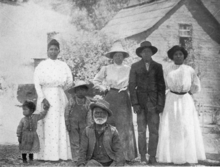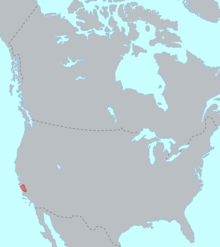Salinan
Te'po'ta'ahl | |
|---|---|
 Miguelino family near Mission San Antonio de Padua | |
| Total population | |
| 681 (2000, census) | |
| Regions with significant populations | |
| Languages | |
| English, formerly Salinan | |
| Religion | |
| Salinan traditional narratives |

The Salinan are a Native American tribe whose ancestral territory is in the southern

Geographic origins
There were two major divisions and one subgroup. From north to south, the Antoniano lived in the lower part of the Salinas Valley (which flows south to north), near the future site of two
and, like most other California tribes, were organized in small groups with little centralized political structure.They left shell middens behind indicating that they lived in the area in numbers along the coast. Their main diet during the summer consisted of fish and shellfish, evidenced by the fine particles of shell present in the soil for a depth of several feet in areas where the Indians camped. The Salinan named the peak Pimkolam.[1][2]
The 56 acres (23 ha)
Etymology
The tribe's name is taken from the
Language
The Salinan language, spoken until the 1950s[11] is a language isolate. It may be a part of the Hokan language family. Sapir included it in a subfamily of Hokan, along with Chumash and Seri; this classification has found its way into more recent encyclopedias and presentations of language families, but serious supporting evidence has never been presented.[12]
Population
Estimates for the pre-contact populations of most native groups in California have varied substantially.
See also
- Salinan traditional narratives
- Kuksu (religion)
- Painted Rock (San Luis Obispo County)
- Chalon
- USS Salinan (ATF-161)
Notes
- ^ Jewell, Jennifer (October 12, 2018). "Obi Kaufmann & The California Field Atlas; Botanical Artistry Of October, Part 2". Cultivating Place (Podcast). North State Public Radio. Retrieved February 13, 2019 – via SoundCloud.
- ISBN 978-1-59714-402-5.
- ^ Clearinghouse, Passport in Time. "Wagon Cave". Passport in Time. Retrieved 31 March 2022.
- ^ "Monterey County Historical Society, Local History Pages--Overview of Post-Hispanic Monterey County History". www.mchsmuseum.com. Archived from the original on 22 May 2006. Retrieved 17 March 2022.
- ^ Cummings, Linda Scott; Puseman, Kathryn; Dexter, Jaime; Eksambekar, Sanjay (2005). "POLLEN, PHYTOLlTH, AND MACROFLORAL ANALYSIS AT SITE CA-MNT-307, CALIFORNIA". Retrieved 2 April 2022.
- ^ "Wagon Caves" (PDF). www.fs.fed.us. Retrieved 31 March 2022.
- ^ Clearinghouse, Passport in Time. "Wagon Cave". Passport in Time. Archived from the original on 17 April 2022. Retrieved 31 March 2022.
- ^ Mason, J. Alden (1856). "The Ethnology of the Salinan Indians" (PDF).
- ISBN 978-0-937401-11-8.
- ^ Hester, p.504
- ^ "Salinan Language and the Salinan Indian Tribe (Sextapay, Antoniano, Migueleno)". Native-languages.org. Retrieved 13 October 2017.
- ^ Marlett 2008
- ^ Kroeber, p.883
- ^ Cook, p.187
- ^ "Census 2000 PHC-T-18. American Indian and Alaska Native Tribes in the United States: 2000" (PDF). September 2002.
References
- Campbell, Lyle (1997). American Indian languages: the historical linguistics of Native America. Oxford: Oxford University Press.
- Cook, Sherburne F. 1976. The Conflict between the California Indian and White Civilization. Berkeley, California: University of California Press.
- Kroeber, Alfred L. 1925. Handbook of the Indians of California. Bureau of American Ethnology Bulletin No. 78. Washington, D.C.
- Hester, Thomas R. 1978. Salinan, in Handbook of North American Indians, vol. 8 (California). William C. Sturtevant, and Robert F. Heizer, eds. Washington, DC: Smithsonian Institution, 1978. ISBN 0-16-004578-9/ 0160045754, pages 500–504.
- Marlett, Stephen A. 2008. The Seri-Salinan connection revisited. International Journal of American Linguistics 74.3:393-399.
- Sapir, Edward. 1925. The Hokan affinity of Subtiaba in Nicaragua. American Anthropologist 27: (3).402-34, (4).491-527.
- National Public Radio segment by Allison Herrera, December 13, 2017
